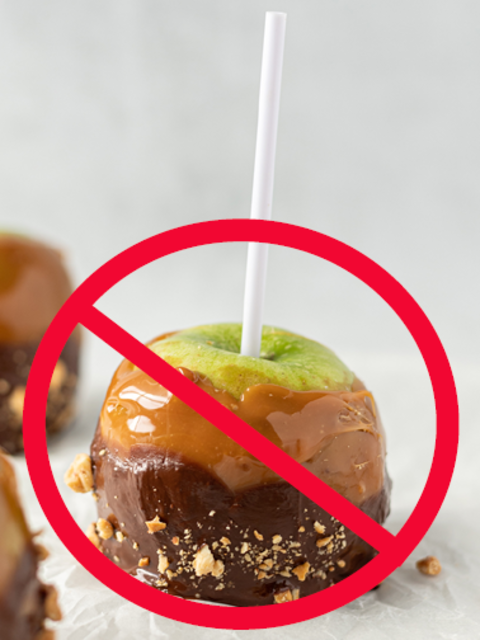Quick facts
- Cottage food producers can sell candied or caramel-coated apples without inserted sticks.
- You cannot sell them with sticks inserted.
- Recent outbreaks of Listeria (a potentially deadly disease) have been associated with eating caramel apples with sticks.
Cottage Food producers may be interested in making and selling candied or caramel-coated apples. The Minnesota Department of Agriculture (MDA) has provided guidance that candied or caramel-coated apples without inserted sticks are allowable under the Cottage Foods Exemption law. The law permits individuals to make and sell non-potentially hazardous foods.
Based on research following the multistate foodborne illness outbreaks related to caramel apples, caramel apples with inserted sticks are a potentially hazardous food. As defined in the Minnesota Food Code, a potentially hazardous food is "capable of supporting the rapid and progressive growth of infectious and toxigenic microorganisms."
This means candied or caramel-coated apples with sticks inserted require refrigeration to minimize the growth of harmful bacteria that may cause illness when eaten. Cottage food processors cannot sell foods that require refrigeration for food safety.
Listeria and foodborne illness
In 2014 and 2017 there were multistate foodborne illness outbreaks caused by Listeria monocytogenes linked to caramel apples. Following these outbreaks, the Centers for Disease Control and Prevention (CDC) recommended food processors make changes to their food handling practices and production environments to reduce the risk of contamination from Listeria monocytogenes. New research identified prevention strategies to reduce or eliminate the pathogen.
Listeria monocytogenes is a pathogen that has been linked to foodborne illness outbreaks from unpasteurized milk and foods made with unpasteurized milk such as soft cheeses and ice cream, raw and processed fruits and vegetables, ready-to-eat deli meats, hot dogs, smoked fish and other seafood, and undercooked poultry and sausages.
Listeria monocytogenes is present in soil in the environment. The pathogen can grow at cold temperatures (below 41°F) and as high as 98°F (warmer than room temperature) and can be spread by cross-contamination from an infected person or food. It is killed by cooking foods to a minimum internal temperature of 165°F.
Symptoms of listeriosis (the illness caused by the pathogen) include fever, muscle aches, nausea or diarrhea. These symptoms can begin 9 to 48 hours after eating the contaminated food, but the bacteria may remain in a person’s intestines for 2 to 6 weeks.
Listeriosis can lead to death, and is especially severe in pregnant women and the fetus, and the elderly.
Researchers studied the growth of Listeria monocytogenes in caramel-coated apples to determine the necessary safe food handling practices to prevent foodborne illness.
A fresh, raw apple is non-potentially hazardous because its pH is usually 4.0 or lower. Caramel can also be non-potentially hazardous because its water activity is usually 0.80 or lower.
Why does the pathogen grow when these two ingredients are combined?
Through testing, the researchers found that the space between the apple and the caramel coating can promote the growth of Listeria monocytogenes. This is because that space contains increased moisture. Also, when a stick is inserted into an apple, any pathogens are moved into the center of the apple where they can rapidly grow.
Pathogen growth is influenced by six main factors, abbreviated as FATTOM: a food source (sugars, starches or proteins), acidity, time, temperature, oxygen and moisture. These factors increased the growth of Listeria monocytogenes in caramel apples with a stick inserted.
For the full research, read the study by K.A. Glass, Growth of Listeria monocytogenes within a Caramel-Coated Apple Microenvironment.
There have been tests with adding a preservative or good probiotic bacteria to the sticks or outside of apples to reduce the risk of pathogen growth, but more testing is needed to duplicate the results.
The Food and Drug Administration (FDA) classifies coating dried/dehydrated fruit and vegetable products as a low-risk activity/food combination. Coating non-dried, non-intact fruits and vegetables is not a low-risk activity/food combination (21 CFR Part 117.5 subpart h).
The current FDA regulatory limit for Listeria monocytogenes is set at “limit of detection,” which means zero tolerance for the presence of the pathogen in ready-to-eat foods.
Angelo KM, Conrad AR, Saupe A, Dragoo H, West N, Sorenson A, Barnes A, Doyle M, Beal J, Jackson KA, Stroika S, Tarr C, Kucerova Z, Lance S, Gould LH, Wise M, Jackson BR. Multistate outbreak of Listeria monocytogenes infections linked to whole apples used in commercially produced, prepackaged caramel apples: United States, 2014-2015. Epidemiol Infect. 2017 Apr;145(5):848-856. doi: 10.1017/S0950268816003083. Epub 2017 Jan 9. PMID: 28065170; PMCID: PMC6542465.
Carstens CK, Salazar JK, Bathija VM, Narula SS, Wang P, Tortorello ML. Control of Listeria monocytogenes in Caramel Apples by Use of Sticks Pretreated with Potassium Sorbate. J Food Prot. 2018 Dec;81(12):1921-1928. doi: 10.4315/0362-028X.JFP-18-175. PMID: 30427727.
Glass KA, Golden MC, Wanless BJ, Bedale W, Czuprynski C. Growth of Listeria monocytogenes within a caramel-coated apple microenvironment. mBio. 2015 Oct 13;6(5):e01232-15. doi: 10.1128/mBio.01232-15. PMID: 26463161; PMCID: PMC4620460. https://pubmed.ncbi.nlm.nih.gov/26463161/
Listeria (Listeriosis). (2022, July, 20). U.S. Food and Drug Administration. https://www.fda.gov/food/foodborne-pathogens/listeria-listeriosis
Marus JR, Bidol S, Altman SM, et al. Notes from the Field: Outbreak of Listeriosis Likely Associated with Prepackaged Caramel Apples — United States, 2017. MMWR Morb Mortal Wkly Rep 2019;68:76–77. DOI: http://dx.doi.org/10.15585/mmwr.mm6803a5
Ward S, Bedale W, Glass KA. Listeria monocytogenes Outbreaks Related to Commercially Produced Caramel Apples: Developments in Sanitation, Product Formulation, and Packaging: A Review. J Food Prot. 2022 Sep 1;85(9):1287-1299. doi: 10.4315/JFP-22-069. PMID: 35666586.
Part 117—Current Good Manufacturing Practice, Hazard Analysis, And Risk–Based Preventive Controls For Human Food. https://www.ecfr.gov/current/title-21/chapter-I/subchapter-B/part-117
Reviewed in 2023


